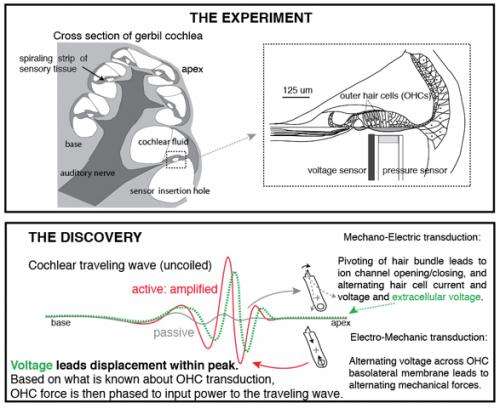New findings on how the ear hears could lead to better hearing aids

A healthy ear is much better at detecting and transmitting sound than even the most advanced hearing aid. But now researchers reporting in the August 20 issue of the Biophysical Journal, a Cell Press publication, have uncovered new insights into how the ear—in particular, the cochlea—processes and amplifies sound. The findings could be used for the development of better devices to improve hearing.
Sound-sensing cells within the cochlea—called hair cells due to the presence of cilia on their membrane surfaces—vibrate strongly at different sound frequencies depending on their location. To examine the cochlear electro-mechanics responsible for this process, Dr. Elizabeth Olson and Dr. Wei Dong, both of Columbia University, designed tiny sensors that could simultaneously measure small pressure fluctuations and cell-generated voltages at specific locations within the ears of live gerbils.
It was previously shown that the pivoting of cilia on a hair cell mechanically opens ion channels in the cell membrane, allowing the current to flow and generate voltage. This sends a signal to a nerve cell, which relays the specific sound frequency signal to the brain. In addition, energy released by hair cell voltage feeds back to amplify the motion specific to that location's frequency, thus driving additional movement of the local hair cells.
Dr. Dong and Dr. Olson discovered that a shift in the timing of this feedback voltage activates amplification at the right frequencies. With the shift, hair cell forces pump energy into cochlear motion, much like a child increases a swing's motion by pumping his legs at the right time. In addition to detecting the amplification trigger, the researchers' sensors verified the amplification that results.
Today's hearing aids—which send amplified signals to the whole cochlea—cannot duplicate this location- and frequency-specific amplification, and understanding how the cochlea accomplishes this may lead to major advances.
"Several groups around the world are devising electromechanical cochlear prostheses, or next-generation cochlear implants. Understanding the micro-mechanical machine of the natural cochlea will inspire and guide these developments," says Dr. Olson.
More information: Biophysical Journal, Dong et al.: "Detection of Cochlear Amplification and Its Activation." dx.doi.org/10.1016/j.bpj.2013.06.049
Journal information: Biophysical Journal
Provided by Cell Press

















